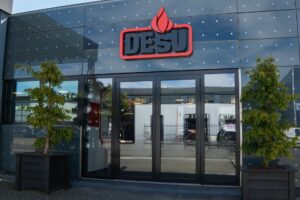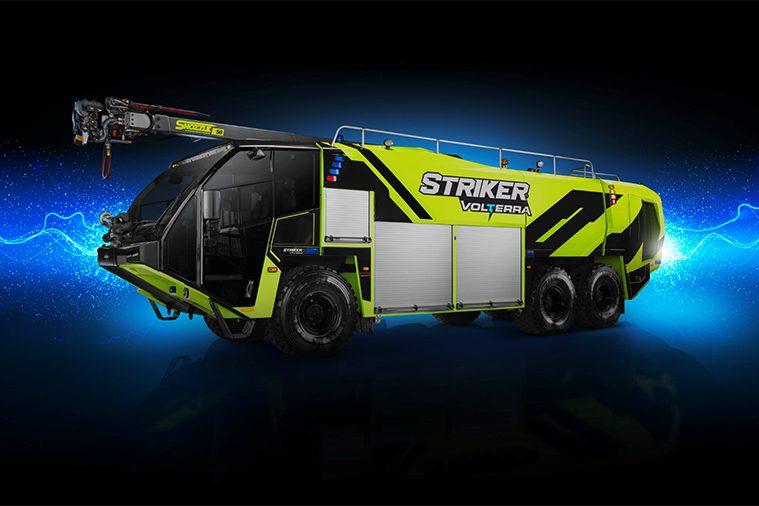Mid-October saw the handover by Rosenbauer of several new HLFs (structural pumpers) to the Frankfurt am Main Professional Fire Service. The trucks are part of a comprehensive replacement program, involving the acquisition of 19 vehicles, during which the entire HLF fleet will be switched to Rosenbauer ATs by the end of the year.
Klaus Tonhäuser, the Rosenbauer Deutschland GmbH CEO, presented the new trucks to Reinhard Ries, the Director of the Frankfurt Fire Directorate, who took this opportunity to thank Rosenbauer for the good and intensive teamwork in past months. For example, the prototype vehicle was tested thoroughly by the fire service in spring before the vehicles are now getting put into service step by step.
Frankfurt’s new main emergency vehicles consist of 19 identical HLF 20 trucks on 15t MAN chassis fitted with a Euro 5 drive train and additional braking system, and designed in line with DIN 14530-27. The main extinguishing technology components consist of an N35 pump with an output of up to 3,500 l/min and an electrically driven and electronically controlled Digimatic pressurised proportioning system. Like the pump, the Digimatic is monitored by the displays of the Rosenbauer Logic Control System (LCS) and owing to its low, infinitely adjustable proportioning rates of 0.1 to 6.0% is ideal for wetting operations. When using foam, extinguishing output amounts to 2,400 l/min at 10 bar.
A special feature of the Frankfurt vehicles is the integration of two connected foam tanks each of which have a 100l volume. If required, firefighters can separate the tanks, which can be filled with differing foam concentrates. In order to create additional space for payload, for the first time the Digimatic has been installed at the back of the vehicle and not as usual in one of the rear equipment compartments. Apart from the two pressure outlets on the left and right of the vehicle, a quick attack reel is installed in equipment compartment 6. In addition, a mobile traffic control reel can be attached to the rear of the truck and a manually operated 5,000l monitor is mounted in equipment compartment 1.
Special infrastructure components also serve to enhance the operational safety of the vehicles. For example, these include three mechanical comfortable lowering devices for the equipment stored on the roof (four-section scaling ladder, three section extension ladder, containers with suction hoses and preventers), as well as overhead power line protection, flaps on the wings, revolving stairs with automatic locking, a comprehensive colour logic system for grips and handles, actuating devices and fixtures for intuitive equipment handling.
The vehicle lighting system is also entirely safety oriented and extends from a lighting mast with six 230V xenon searchlights, which can be rotated and swivelled, to surrounding area lighting consisting of three powerful LED lamps on both the left and right of the truck, and top quality, LED lighting in the cabin and equipment compartments. Front and reversing cameras, as well as manoeuvring searchlights mounted on the rear view mirrors further enhance driving safety, while a direction indicator in the cabin informs the crew as soon as the driver activates a blinker or the brakes.
In addition to front and rear flashing lights, four Martin compressed air horns and a rear-mounted LED traffic direction unit serve as warning systems. For the electricity supply at the operational scene, a portable generator is mounted on a revolving pullout in equipment compartment 4. The generator’s exhaust gas system runs up to the vehicle roof and in order to create the required space, a special 1,600l water tank with an opening for the exhaust gas line has been developed and installed.
The warning devices, generator and lighting mast can be controlled from displays in the driver’s cab and at the back of the vehicle. The driver’s and crew cabins, as well as all the equipment compartments have central locking. The cab is fitted with electrical windows and glass doors for better vision when leaving the vehicle and even temperatures in the driver’s and crew cabins are ensured throughout the year by an air conditioning system mounted in the cab roof and stationary heating. A total of six SCBA fittings (five in the cab, one on the co-driver’s seat) are installed along with a basic range of extended first aid equipment (safety helmet, emergency and intensive backpack, defibrillator, etc.), which is contained in the so-called action tower in the cab. A heat-imaging camera is also close at hand.
Apart from the standard payload, a fold-out, rotating breathing apparatus monitoring panel is available together with a pullout hygiene board with water and compressed air outlets, soap and hand towel dispensers for rough cleaning. Nine sorting crates are mounted on a revolving pullout in equipment compartment for the extremely space-saving storage of small parts and tools.
The Frankfurt am Main Professional Fire Service is among the most modern in the world and the technology employed in its new HLFs is equally advanced and innovative. In future, these trucks will form the backbone of the Frankfurt fleet and be part of virtually every alarm response. Apart from the 19 HLFs, the Frankfurt service has 20 pumpers, 14 rescue trucks, ten aerial ladders, four large tankers and four swap body vehicles. The service protects the roughly 25 hectares of the Frankfurt inner city area with its population of around 700,000. Twelve constantly manned fire and rescue departments are spread across the entire urban area and all in all, the professional fire service has some 1,000 employees.
Among the HLFs handed over in mid-October was the 3,600th Rosenbauer AT. The AT (Advanced Technology) is therefore one of the Europe’s best-selling municipal fire trucks. The vehicle made its debut at the Interschutz 1994 and current production represents the third generation.
From the outset, the AT was characterised by its superstructure design consisting of torque-resistant, bolted and bonded, aluminium sandwich panels. This creates a weight reduction that is employed for the accommodation of additional payload, while large openings with roller blinds offer improved equipment access and an ingenious storage system provides up to 20% more room in the superstructure.
One of the trademarks of the AT is the interlocking of the driver’s cab with the superstructure, which enhances both the appearance of the vehicle and its handling. The third generation AT has been on the market since 2011 and incorporates comprehensive LED lighting technology, modern communications systems, new displays, numerous operational aids, a central water axis and some ninety new features.




































